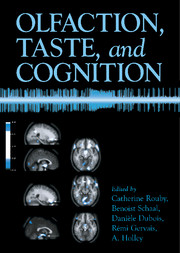Book contents
- Frontmatter
- Contents
- Contributors
- Preface
- Acknowledgments
- A Tribute to Edmond Roudnitska
- OLFACTION, TASTE, AND COGNITION
- Section 1 A Specific Type of Cognition
- Section 2 Knowledge and Languages
- Section 3 Emotion
- Section 4 Memory
- Section 5 Neural Bases
- Section 6 Individual Variations
- 24 New Psychophysical Insights in Evaluating Genetic Variation in Taste
- 25 The Individuality of Odor Perception
- 26 Olfactory Cognition at the Start of Life: The Perinatal Shaping of Selective Odor Responsiveness
- 27 Age-related Changes in Chemosensory Functions
- Index
- References
27 - Age-related Changes in Chemosensory Functions
Published online by Cambridge University Press: 21 September 2009
- Frontmatter
- Contents
- Contributors
- Preface
- Acknowledgments
- A Tribute to Edmond Roudnitska
- OLFACTION, TASTE, AND COGNITION
- Section 1 A Specific Type of Cognition
- Section 2 Knowledge and Languages
- Section 3 Emotion
- Section 4 Memory
- Section 5 Neural Bases
- Section 6 Individual Variations
- 24 New Psychophysical Insights in Evaluating Genetic Variation in Taste
- 25 The Individuality of Odor Perception
- 26 Olfactory Cognition at the Start of Life: The Perinatal Shaping of Selective Odor Responsiveness
- 27 Age-related Changes in Chemosensory Functions
- Index
- References
Summary
Early in this century it was shown that aging is accompanied by a decrease in intranasal chemosensory sensitivity to camphor (Vaschide, 1904). Numerous studies have confirmed such findings for various odorants (Venstrom and Amoore, 1968; Schiffman, Moss, and Erickson, 1976; Stevens and Cain, 1987). Others have reported decreased ability to identify odorants with increasing age (Doty et al., 1984; Wood and Harkins, 1987; Cain and Gent, 1991), as well as greater tendencies for olfactory adaptation and slower recovery of threshold sensitivity (Stevens et al., 1989). In contrast, few investigators have reported stable olfactory function over a life span (e.g., Rovee, Cohen, and Shlapack, 1975).
What Is the Anatomical Substrate for Age-related Loss of Chemosensory Function?
The olfactory system is part of a living organism that undergoes significant changes related to aging. Both peripheral sensory and central processing units are affected in that process. In the following we shall try to summarize some of those effects concerning the aging olfactory epithelium, as well as changes in the central nervous system that may contribute to the deterioration of the aging sense of smell.
Central Nervous System and Olfactory Bulb
Olfactory receptor neurons (ORNs) may be subject to alterations similar to those seen in neurons in the aging brain. Alterations in the aging central nervous system (CNS) include, for example, deficits in the regulation of intracellular calcium levels, increased leakage of synaptic transmitters, and changes in neuronal arborization (Smith, 1988).
- Type
- Chapter
- Information
- Olfaction, Taste, and Cognition , pp. 441 - 456Publisher: Cambridge University PressPrint publication year: 2002
References
- 23
- Cited by

